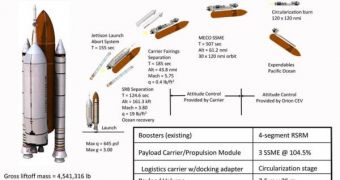Since US President Barack Obama asked the Review for US Human Space Flight Plans panel to investigate the National Aeronautics and Space Administration (NASA), its members have taken their jobs seriously. They looked into Project Constellation, analyzed progress, costs, budget overruns, and benefits, and noted their conclusions on paper. Then, they took a long look at the Shuttle Program, and also wrote things down. Now, a few weeks before they are due to present their findings and recommendations to Obama, the panel members are displaying their potential list of scenarios that NASA could pursue in the future, and they vary quite extensively.
The initial lists of possible options had about 3,000 options, which the panel eventually reduced to no more than seven general scenarios, encompassing most of them. However, members say that these scenarios will be reduced in number as well, until the meeting with the president. In a televised meeting that took place yesterday in Washington DC, former Lockheed Martin CEO and chairman of the committee Norman Augustine said that “We have our work cut out for us,” referring to the vast amount of data that the panel needs to go through before presenting its assessments.
According to the time line of Project Constellation, which is now NASA's main direction of development, the ARES I delivery system and that of Orion Crew Exploration Vehicle are scheduled to start their runs in 2015. The planned ARES V heavy-lift rocket is also scheduled to start flying at that time, carrying the Altair Lunar Lander, and other heavy cargo to the Earth's orbit and beyond. The space agency also plans to retire the aging shuttle fleet by the end of 2010, when construction efforts on the International Space Station (ISS) are completed. From that time to 2015, RosCosmos will remain the only space agency able to put astronauts in orbit, next to the Chinese.
“NASA has brilliant people. Get attention of these brilliant people on the harder tasks, and think of buying the easier tasks from [commercial] industry. NASA would show off their skills by doing the hard stuff (...) I think that process would elevate NASA in stature in America,” says former Boeing manager Bohdan Bejmuk, who is leading one of the subcommittees of the panel, quoted by Space.
Among the committee's options are cutting funds for ARES I and focusing on ARES V, as well as plans to quit the US involvement in low-Earth orbit and focusing efforts on Mars or the Moon. Other scenarios call for new space vehicles that would be derived directly from the shuttles, and the reduction of the plans now associated with Project Constellation. The final recommendations will be made public around the end of this month.

 14 DAY TRIAL //
14 DAY TRIAL //